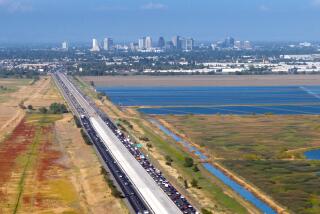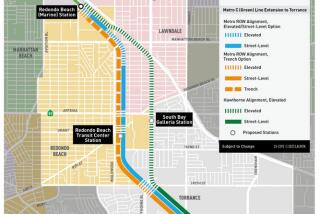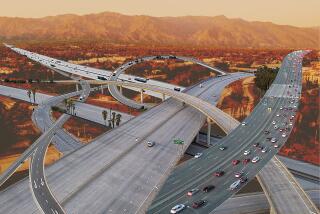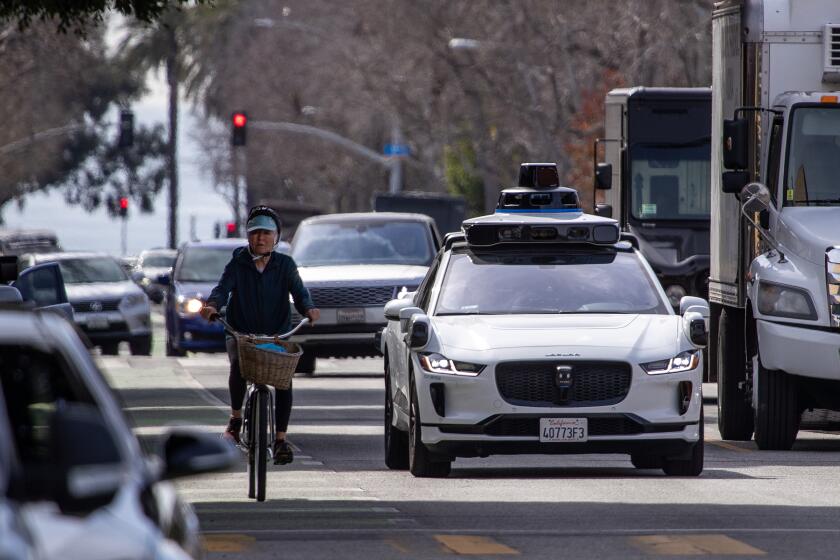Engineer Says Left Turn on C Street Would Slow Traffic
- Share via
Dear Street Smart:
If you’re going east or west on Wooley Road at C Street in Oxnard, the traffic light has a left turn signal. But if you’re going north or south on C Street at the same intersection, there is no left turn signal. Without a left turn arrow, you have to wait for oncoming traffic and only two or three cars can get through. I get stuck there all the time. It’s a simple matter. Why don’t they put in a left turn arrow on C street? (It will be interesting to see what kind of excuse they have for this one.)
Herbert E. Hewston, Oxnard
Dear Reader:
Obviously, you haven’t been pleased with answers the city has given to your questions before. And I doubt you will be pleased with this one. But here goes.
Joe Genovese, Oxnard’s traffic engineer, said traffic is much heavier on Wooley Road than on C Street and to put a left turn signal on C Street would slow traffic down considerably.
“It would tend to bog down the intersection,” Genovese said. “It would help a few at the expense of the rest of the traffic.”
He said 23,000 vehicles a day travel through the intersection on Wooley Road, as opposed to 18,000 on C Street. And 13.4% of the traffic on Wooley Road uses the left turn lanes, compared to 10% on C Street.
Genovese said to put in a left turn signal on C Street would also mean that traffic lights all along Wooley Road would have to be reset, thereby making the roadway less efficient.
*
Dear Street Smart:
In my commutes to Ventura, I have noticed what looks like some sort of satellite dish on a few of the signposts on the Ventura Freeway--at the northbound off-ramp to Victoria Avenue and the southbound off-ramp to Johnson Drive. Exactly what are these devices and what purpose do they serve?
Lance O’Fallon, Thousand Oaks
Dear Reader:
When Street Smart first contacted Caltrans officials about the mysterious “satellite dishes,” they were as perplexed as we were. Probably more so.
“I sent somebody over there and they couldn’t find anything like what you were talking about,” said an adamant Ali Peykanu, a Caltrans spokesman. “As far as we’re concerned, there’s nothing there.”
But they don’t call us Street Smart for nothing. Further investigation revealed that the metal dish-shaped objects you referred to do indeed exist. Only they’re not satellite dishes; they’re “rat guards.”
Wayne Smith, Caltrans’ sign maintenance supervisor in Ventura County, informed us that the rat guards are actually designed to keep people--not little furry animals--from climbing up the posts and defacing the freeway signs with graffiti. The guards wrap around the posts, blocking access to the signs.
“It’s an anti-graffiti appliance we started using in Ventura County as opposed to razor wire that is used in Los Angeles,” Smith said. “Ventura County is still a suburban and rural community. We don’t want to use military-style graffiti control.”
He said Caltrans two months ago installed four rat guards on Ventura Freeway sign posts--all within the city of Ventura--as part of a pilot program. Caltrans put the guards up after someone tagged a dozen signs in one day.
Smith said the rat guards cost $250, take only about 30 minutes to install, and are far cheaper and safer than razor wire. He said Caltrans has successfully used the guards in Orange and San Diego counties.
*
Dear Street Smart:
If you are southbound on Erbes Road in Thousand Oaks and make a right turn on Hillcrest Drive, there is no way you can stay in the right-hand lane let alone turn into the left-hand lane without almost running into the curb. When the intersection was upgraded and a new traffic signal installed a year ago, the right-turn lane was eliminated. Does the city or the traffic division know how awful the intersection is now? Are there any plans to reconfigure it?
Jill Schaeffer, Thousand Oaks
Dear Reader:
John Clement, Thousand Oaks’ public works director, said the city spent $145,000 to redesign the intersection and install the traffic signal in June of last year. He said it has no intention of going back and realigning the roadway.
Clement said the “flip lane,” or right-turn lane you referred to was eliminated to help improve traffic flow through the intersection and also increase pedestrian safety. “We felt it was safer to tighten it up,” he said.
Despite your complaints about the hard right turn that was created by the “improvements,” Clement said the intersection was “no different than any other in the city.
“Sure, it’s not as easy a turn as it was before,” Clement conceded, “but it’s certainly not a hard turn.”
More to Read
Sign up for Essential California
The most important California stories and recommendations in your inbox every morning.
You may occasionally receive promotional content from the Los Angeles Times.













